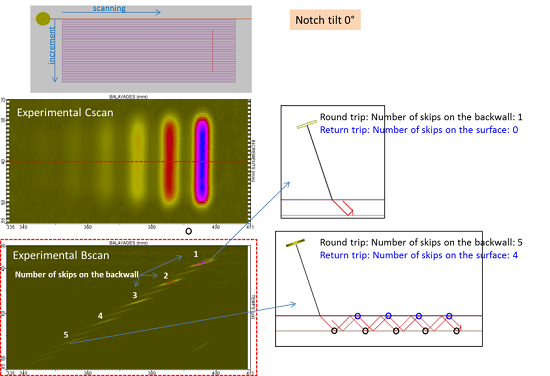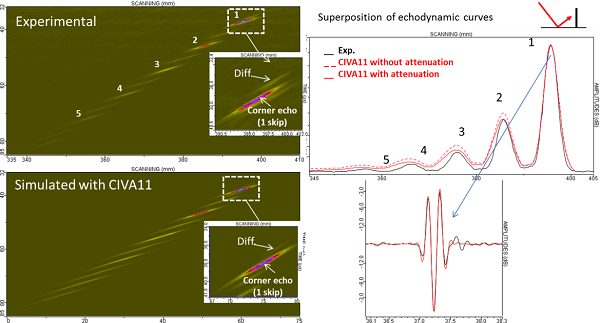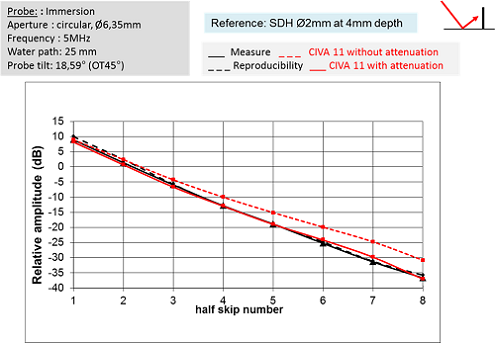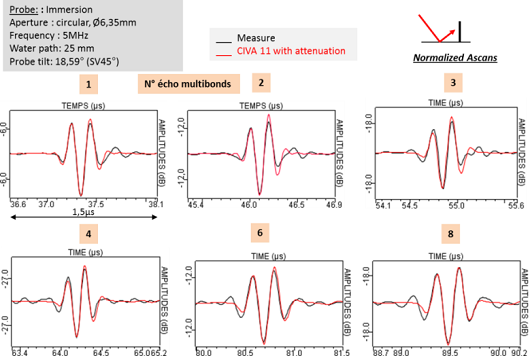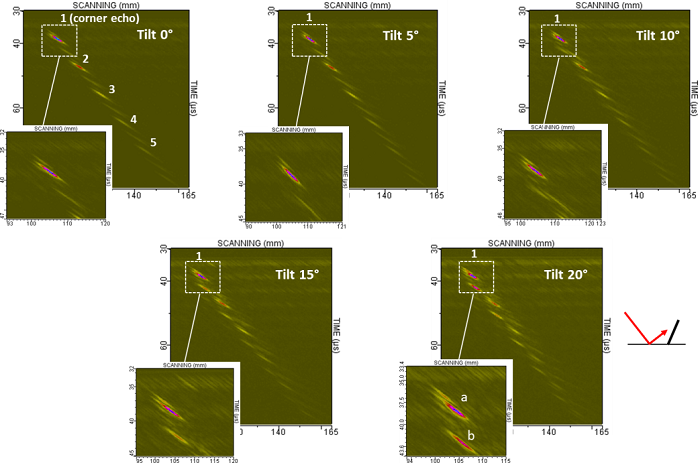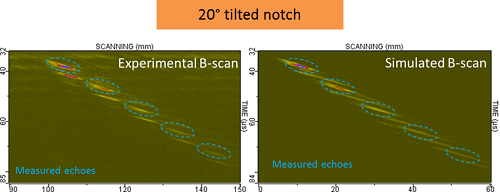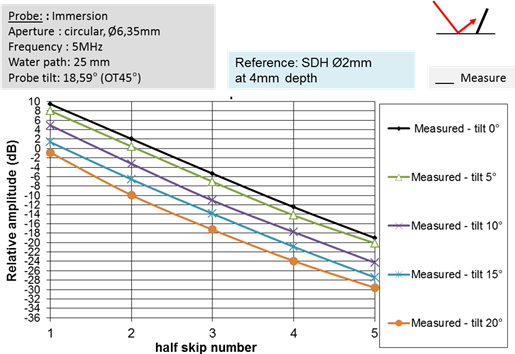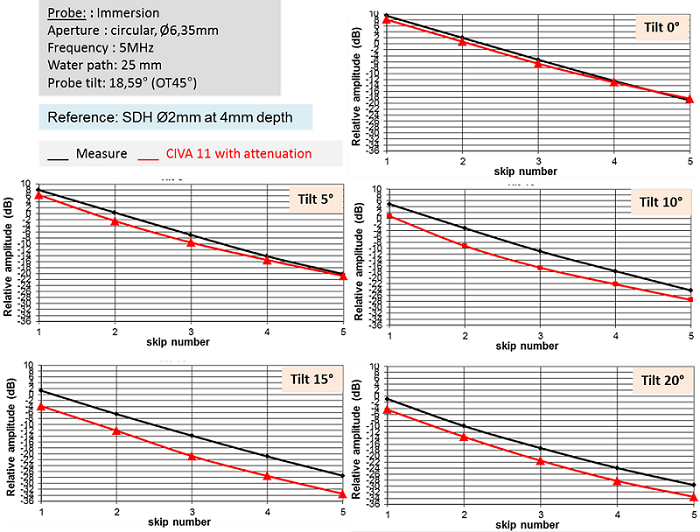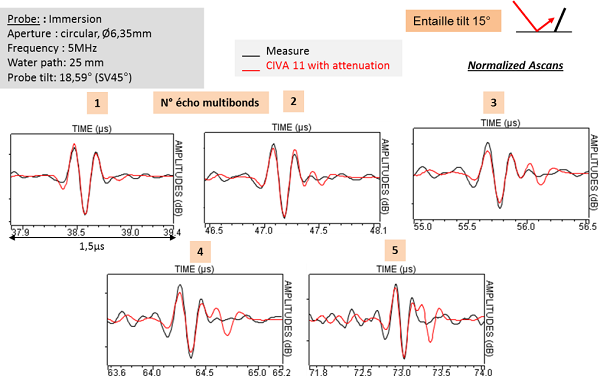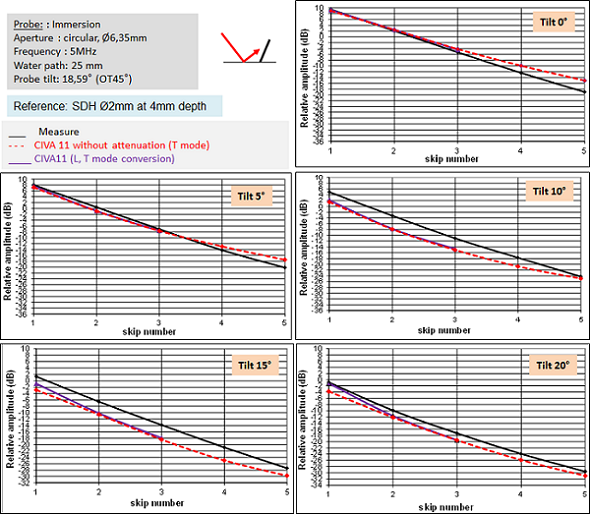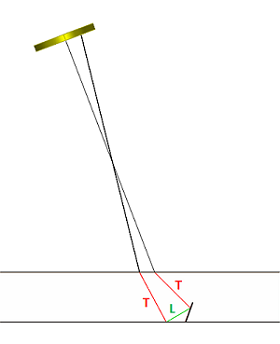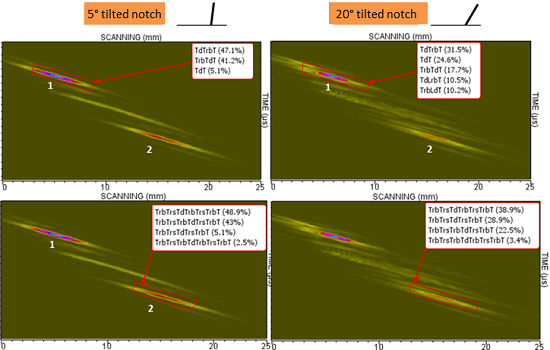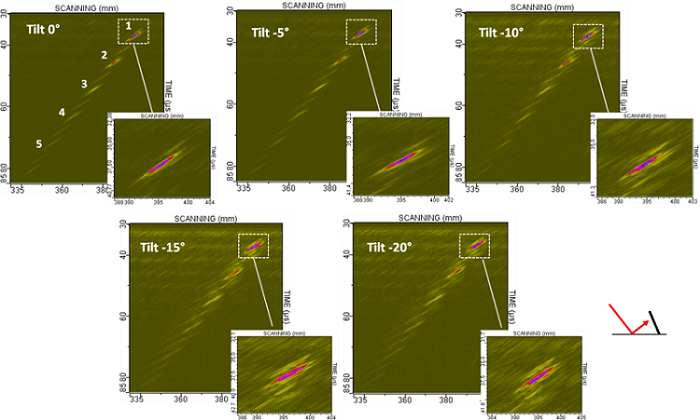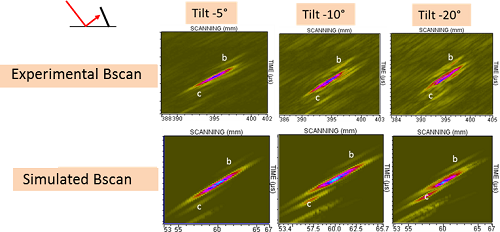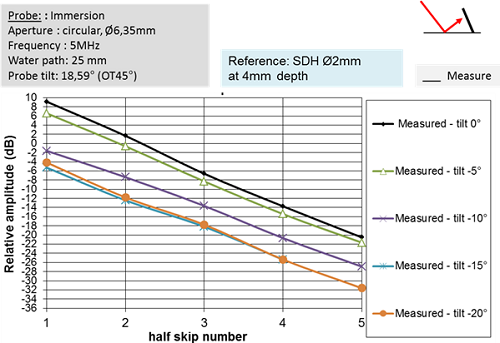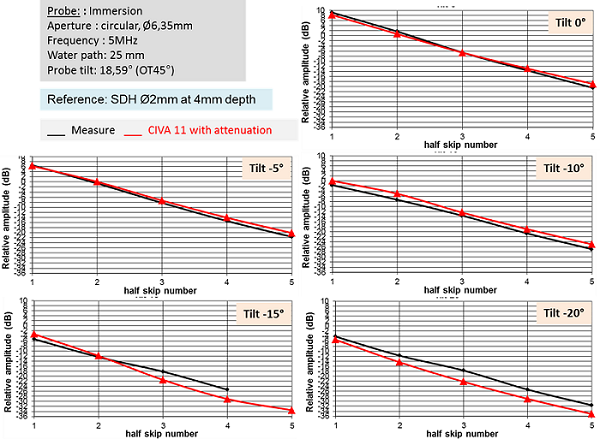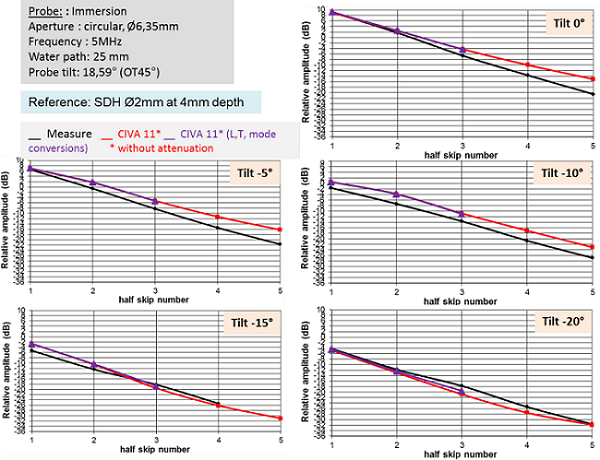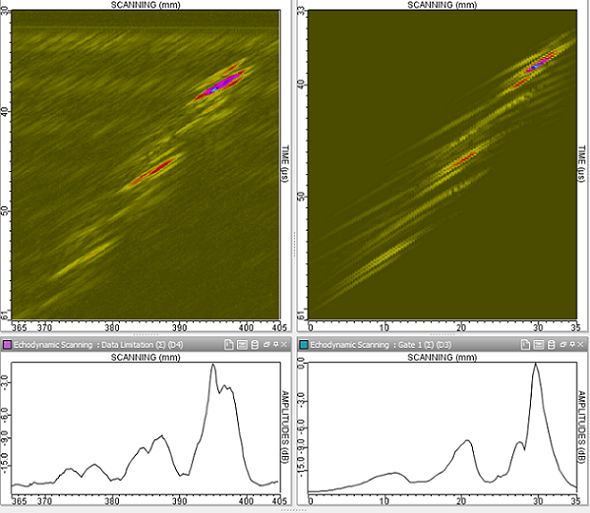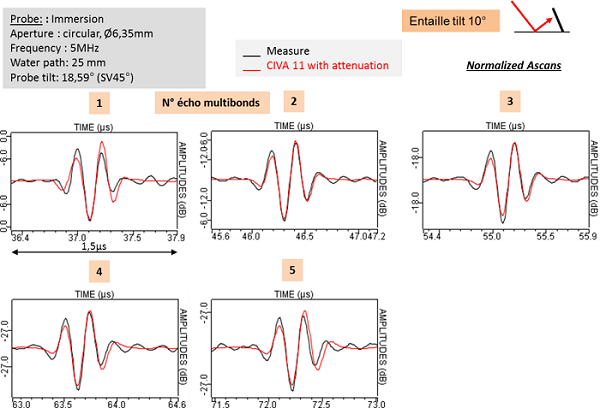UT – Multiple echoes: Results for the 5 MHz single element probe generating T45° waves
Summary
The probe has an incidence angle of 18.6° in order to generate T45° waves in the multi-skip mock-up. The probe incidence angle is 19.2° when it is used to measure SDH echoes. The reference amplitude corresponds to the response of the Ø2 mm SDH located at 5 mm depth T45°:
- Results with a vertical notch
- Results with an opened tilt angle configuration
- Results with a closed tilt angle configuration
Results with a vertical notch
The figure below shows a Cscan of a vertical notch. The Bscan is extracted at the middle of the defect (red dotted line on the Cscan). The echoes with the highest amplitude (n°1 to 5 on the figure) are named “multi-skip” echoes and are associated with ultrasonic paths for which the difference between the number of skips on the backwall while round trip (probe to notch) and the number of skips on the surface while return trip is equal to 1.
The comparison between simulation and experiment multi-skip echoes n°1 to 5 shows a good agreement. However, there are differences between experimental and simulated echodynamic curves: the simulated echoes are wider than experimental ones when the number of skips is greater than or equal to 2.
Experimental and simulated maximum amplitude of multi-skip echoes are plotted below. The curves show that the amplitude decreases linearly with the number of skips. There are 46 dB differences between the amplitude of echo n°1 and echo n°8. This behavior is correctly reproduced by CIVA 11 (maximal error of 2 dB) when attenuation is taken into account.
The Ascans obtained with CIVA 11 are also in good agreement with experiment.
Additional results are available here. These results have been obtained on a planar block of 12mm thickness. The notch is backwall breaking and its diemnsions are 2x10mm.
Results with an opened tilt angle configuration
Experimental Bscan obtained with 0° to 20° tilted notches (opened tilt angles) are presented below.
After skip n°1, 15° and 20° tilted notches show two main contributions (echoes a and b on the figure above). This is not the case for not almost tilted or not tilted notches since they are composed of only one echo. This phenomenon is not correctly simulated with CIVA as it can be seen on the figure below.
The experimental multi-skip echoes amplitude evolution decreases linearly with the number of skips on the backwall (cf. curves below). The amplitude decrease stays the same whatever the notch tilt angle: 28 dB decrease between corner echo n°1 and echo n°5.
CIVA 11 makes good prediction of the amplitude decrease with the number of skips. However, whatever the number of skips, when the tilt becomes greater or equal to 10°, CIVA underestimates the echoes amplitude. The differences between measured and simulated echoes reach 4 to 5 dB on the 15° tilted notch. Because this happens with all the multi-skip echoes, the difference is not due to simulated attenuation.
Superposition of experimental and simulated Ascan for the 15° tilted notch is presented on the figure below. There is a good agreement between the results. However when the number of skips becomes bigger than 3, an additional contribution is simulated by CIVA.
Simulations taking into account L, T and conversion mode were performed for the first 3 skips. Attenuation was not accounted for. Therefore, the obtained results were compared to the ones obtained with only T waves and no attenuation. Results show that taking into account mode conversion changes the amplitude of multi-skip echo n°1 when the notch is tilted with 15° and 20°. The amplitude is 2 dB to 3 dB bigger than the one obtained without conversion.
This increase in amplitude is due to the mixed corner echo which is mixed with the T corner echo.
Results with a closed angle tilt configuration
The figure below shows experimental Bscans of -20° to 0° tilted notches (closed angle tilt). CIVA predicts well the main contribution of the multi-skip echoes.
However, the comparison of experimental and simulated Bscans shows that contributions b and c (see figure below) are not correctly predicted. These ones won’t be studied in this document.
The multi-skip echoes amplitude decreases linearly with the number of skips and does not depend on the tilt. There is 28 dB difference between multi-skip echo n°1 and n°5.
The decrease in amplitude is correctly predicted by CIVA 11. The difference between CIVA and experiment for -5° and -10° tilted notches is less than 2 dB. The biggest differences are less than 4 dB and are observed for -15° and -20° tilted notches.
Simulations with all possible mode conversion for the 3 first multi-skip echoes were performed. In these simulations attenuation was not taken into account. They are compared with the ones performed with only T waves and no attenuation neither. The results of both simulations are quite similar (less than 1 dB difference).
The figure below presents a comparison experiment/simulation of Bscans and echodynamic curves when L, T and mode conversion are taken into account for the -15° tilted notch. It shows that the echoes around the main contribution of multi-skip echoes are not always correctly predicted by CIVA.
On the other hand, there is a good agreement between experimental and simulated Ascans of the 15° tilted notch.
CONCLUSION
Inspections of backwall breaking notches, in a 5 mm depth planar specimen were performed with a 5 MHz immersion probe. The incidence angle of the probe was chosen in order to generate T45° waves in the mock-up.
T45° experiments show that the corner echo amplitude decreases linearly with the number of skips. There are 28 dB difference between the amplitude of corner echo n°1 and corner echo n°5. This decrease stays the same whatever the notch angle (between -20° and +20°). This behavior is well predicted by CIVA 11. However, there are few differences between simulation and experiment on the shape and amplitude of the echoes. Simulated echoes become wider than experimental ones starting from the second skip and there is up to 4 dB difference for +/- 15° et +/-20° tilted notches. When taking into account mode conversion, multi-skip corner echoes amplitudes stay almost constant except for echo n°1 of highly tilted notches (+/-15° et +/-20°) for which +2 to 3 dB are measured. This is not the case when simulations do not take into account mode conversions. This difference is due to the mixed corner echo that mixes itself with the T corner echo.
Continue to Results for the 5 MHz single element transducer generating P45 waves

